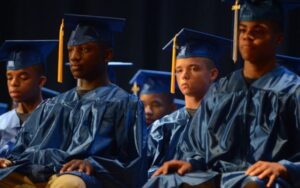For at least three years running, the City of Richmond Public Schools (RPS) ranked as the school system with the lowest graduation rate in Virginia. Yet, despite the travails of a COVID epidemic that kept most students home most of the time, school officials are projecting a 14 percentage-point increase in the graduation rate to almost 85%, with the most dramatic gains seen among Latino and economically disadvantaged students.
“We’re finally gaining traction based on the past three years of our efforts,” said Tracy Epp, RPS’ chief academic office, according to the Richmond Times-Dispatch.
How did such a turnaround take place, even as many students struggled with Internet connectivity or studied at homes where working parents could provide no supervision?
Such a dramatic change of fortune sounds too good to be true — and perhaps it is. There is abundant anecdotal evidence from around the state of students logging into classes and turning off the audio and video feeds. But let’s give RPS the benefit of the doubt. Perhaps adversity inspired everyone to rise to the occasion. What do school officials say made the difference?
By way of background, it is important to note that before the arrival of Superintendent Jason Kamras, Richmond schools were misusing administrative tricks to inflate the graduation rate. After Kamras cleaned up the abuses, the graduation rate dropped as low as 70% compared to a statewide rate of more than 91%.
Joe Pasani, principal of George Wythe High School, said he kept his expectations high and refused to accept excuses. “I think there was a strong administrative focus on ‘Do we know each graduate? Do we know their story? And do we know what we need to do to ensure they graduate?'”
Latino students saw the most extraordinary gains — from 33% graduating the previous year to 60% in 2021. City schools had struggled with the Latino students, most of who were English learners. Latino enrollments had increased by 60% over five years to reach more than 5,000 last year. An audit found that 9th and 10th graders were being placed in general education ELL classes that did not earn them credits toward graduation. (The article did not say what changes school officials made to count more credits.) Also, the Con Ganas program, which serves English language learners who “might not fit a traditional school model,” created a center where students could do dropout recovery. A team of liaisons visited the homes of dropouts and potential dropouts in the hopes of getting them back in school. The liaisons would try to identify the problems and offer options like night school or virtual learning.
Do the statistics reflect real changes in student behavior and real gains in learning, and not just a collapse in standards? The only way to know for sure may be to get real-world feedback from employers. Are Richmond’s high school graduates functionally literate and numerate enough to perform the kinds of jobs that high school students are supposed to be able to do? For the good of the children and the reputation value of a Richmond high school degree, I hope so.



